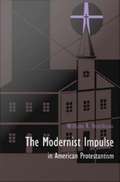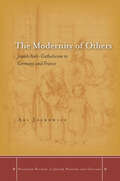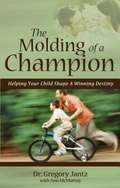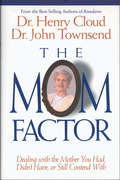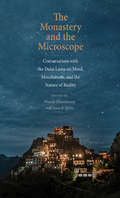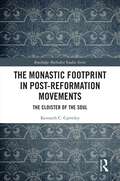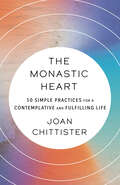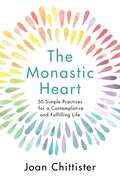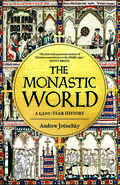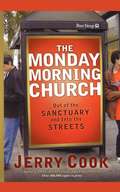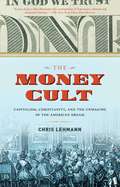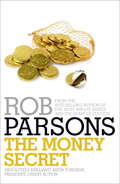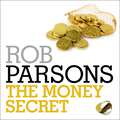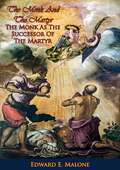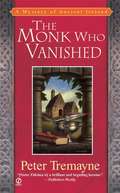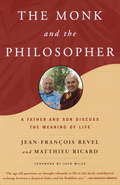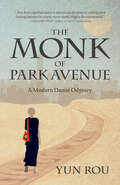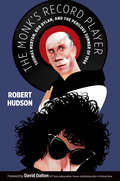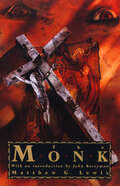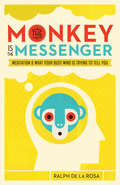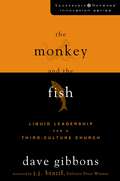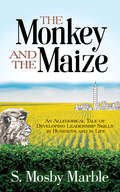- Table View
- List View
The Modernist Impulse in American Protestantism
by William R. HutchisonThis landmark study of American religion, recipient of the National Religious Book Award in 1976, is being brought back into print with an updated bibliography. The Modernist Impulse in American Protestantism traces the history of American Protestant thought from the early part of the nineteenth century to the present. William R. Hutchison deals especially with the "modernist" movement that flourished in the years around 1900, and with the colorful personalities and disputes associated with that movement.
The Modernity of Others: Jewish Anti-Catholicism in Germany and France
by Ari JoskowiczThe most prominent story of nineteenth-century German and French Jewry has focused on Jewish adoption of liberal middle-class values. "The Modernity of Others" points to an equally powerful but largely unexplored aspect of modern Jewish history: the extent to which German and French Jews sought to become modern by criticizing the anti-modern positions of the Catholic Church. Drawing attention to the pervasiveness of anti-Catholic anticlericalism among Jewish thinkers and activists from the late eighteenth to the early twentieth century, the book turns the master narrative of Western and Central European Jewish history on its head. From the moment in which Jews began to enter the fray of modern European politics, they found that Catholicism served as a convenient foil that helped them define what it meant to be a good citizen, to practice a respectable religion, and to have a healthy family life. Throughout the long nineteenth century, myriad Jewish intellectuals, politicians, and activists employed anti-Catholic tropes wherever questions of political and national belonging were at stake: in theoretical treatises, parliamentary speeches, newspaper debates, the founding moments of the Reform movement, and campaigns against antisemitism.
The Molding of a Champion
by Dr Gregory JantzToday's culture puts a tremendous emphasis on being competitive-- being a winner in life, in a career, and in a perfect relationship. The pressure to succeed can be one of the toughest aspects of growing up for young people in this success-driven society. From his base in the Pacific Northwest, Dr. Gregg Jantz, over the last two decades, has cemented his reputation as one of the country's finest psychologists. His particular passion is seeing young people become everything God intends them to be. In this remarkable new book, Dr. Jantz shares a wealth of wisdom for parents to help shape their child's future in a successful, and faith-strengthening way. Going beyond the standard strategies into a unique perspective drawn from his years of experience in professional practice, along with his own parenting journey, Dr. Jantz offers workable solutions for relationships, drug and alcohol addictions, body image struggles, and living life with purpose.
The Mom Factor: Dealing with the Mother You Had, Didn't Have, or Still Contend With
by Henry Cloud John TownsendFrom the very beginning, you relied on her for things no one else could give you. How she met those needs -- or didn't meet them -- affected you daily as a child. And still affects you profoundly as an adult. For every son or daughter who wonders if things should have been different . . . for every man or woman who wonders if they still couldn't be . . . here's a life-changing look at The Mom Factor. She shaped you in ways that would surprise you both. No one has influenced the person you are today like your mother. The way she handled your needs as a child has shaped your worldview, your relationships, your marriage, your career, your self-image -- your life. How can you identify areas that need reshaping, make positive choices for personal change, and establish a balanced, mature relationship with Mom today? In The Mom Factor, Drs. Henry Cloud and John Townsend steer you down a path of discovery and growth beyond the effects of six common mothering styles: -The Phantom Mom -The China-Doll Mom -The Controlling Mom -The Trophy Mom -The Still-the-Boss Mom -The American-Express Mom -- Cloud and Townsend show you how your mom affected you as a child and may still be affecting you today. You’ll find a hopeful, realistic, and empowering approach to identifying your unmet mothering needs and filling them in healthy, life-changing ways through other people. This encouraging book doesn’t just help you understand areas in your life that need change and strengthening -- it helps you apply your discoveries to attain new freedom and joy in living, and an increased ability to give and receive love. The Mom Factor is a biblical, highly practical route to wholeness and growth, deeper and more satisfying bonds with your family, friends, and spouse -- and a new, healthier way of relating to your mother today.
The Mom God Chose: Mothering Like Mary
by Sarah HabbenWho was Mary, the mother of God?As the mother of Jesus, Mary faced her fair share of challenges and heartache. Even today, we can learn a lot from her struggles and successes!In The Mom God Chose, you’ll discover timeless truths for raising your children in God’s grace. You’ll also be reminded that motherhood is a blessing from your heavenly Father.In addition to 24 thought-provoking and inspiring devotions, this book also includes interviews of present-day moms and their insights for raising godly children, and helpful study questions!
The Moment Between
by Nicole BaartTragedy pushed Abigail Bennett to the brink of something she's never experienced: Obsession. His name is Tyler Kamp. As Abigail follows him across the border into Canada, her journey is awash in memories of family and childhood, especially those of her younger sister Hailey. Even as Abigail races into her future, her past pulls her back. Only when she is brought to the edge of her obsession will she be able to come to terms with the tragedy that ignited it.
The Monastery and the Microscope: Conversations with the Dalai Lama on Mind, Mindfulness, and the Nature of Reality
by Wendy Hasenkamp Janna R. WhiteAn illuminating record of dialogues between the Dalai Lama and some of today’s most prominent scientists, philosophers, and contemplatives In 2013, during a historic six-day meeting at a Tibetan monastery in southern India, the Dalai Lama gathered with leading scientists, philosophers, and monks for in-depth discussions on the nature of reality, consciousness, and the human mind. This eye-opening book presents a record of those spirited and wide-ranging dialogues, featuring contributions from prominent scholars like Richard Davidson, Matthieu Ricard, Tania Singer, and Arthur Zajonc as they address such questions as: Does nature have a nature? Do you need a brain to be conscious? Can we change our minds and brains through meditation? Throughout, the contributors explore the exciting and sometimes surprising commonalities between Western scientific and Tibetan Buddhist methods of perceiving, investigating, and knowing. Part history, part state-of-the-field, part inspiration for the future, this book rigorously and accessibly explores what these two investigative traditions can teach each other, and what that can tell us about ourselves and the world.
The Monastic Footprint in Post-Reformation Movements: The Cloister of the Soul (Routledge Methodist Studies Series)
by Kenneth C. CarveleyThis book examines the influence of the monastic tradition beyond the Reformation. Where the built monastic environment had been dissolved, desire for the spiritual benefits of monastic living still echoed within theological and spiritual writing of the seventeenth and eighteenth centuries as a virtual exegetical template. The volume considers how the writings of monastic authors were appropriated in post-Reformation movements by those seeking a more fervent spiritual life, and how the concept of an internal cloister of monastic/ascetic spirituality influenced several Anglican writers during the Restoration. There is a careful examination of the monastic influence upon the Wesleys and the foundation and rise of Methodism. Drawing on a range of primary sources, the book will be of particular interest to scholars of monastic and Methodist history, and to those engaged in researching ecclesiology and in ecumenical dialogues.
The Monastic Heart: 50 Simple Practices for a Contemplative and Fulfilling Life
by Joan ChittisterThe activist, nun, and esteemed spiritual voice who has twice appeared on Oprah Winfrey&’s Super Soul Sunday sounds the call to create a monastery within ourselves—to cultivate wisdom and resilience so that we may join God in the work of renewal, restoration, and justice right where we are.&“Essential reading for anyone wishing to find the compass of their heart and the wellspring from which to live fully.&”—Gregory Boyle, founder of Homeboy Industries and New York Times bestselling author of Tattoos on the Heart &“In every beating heart is a silent undercurrent that calls each of us to a place unknown, to the vision of a wiser life, to become what I feel I must be—but cannot name.&” So begins Sister Joan Chittister&’s words on monasticism, offering a way of living and seeing life that brings deep human satisfaction. Amid the astounding disruptions of normalcy that have unfolded in our world, Sister Joan calls all of us to cultivate the spiritual seeker within, however that may look across our diverse journeys: &“We can depend only on the depth of the spiritual well in us. The well is the only thing that can save us from the fear of our own frailty.&”This book carries the weight and wisdom of the monastic spiritual tradition into the twenty-first century. Sister Joan leans into Saint Benedict, who, as a young man in the sixth century, sought moral integrity in the face of an empire not by conquering or overpowering the empire but by simply living an ordinary life extraordinarily well. This same monastic mindset can help us grow in wisdom, equanimity, and strength of soul as we seek restoration and renewal both at home and in the world.At a time when people around the world are bearing witness to human frailty—and, simultaneously, the endurance of the human spirit—The Monastic Heart invites readers of all walks to welcome this end of certainty and embrace a new beginning of our faith. Without stepping foot in a monastery, we can become, like those before us, a deeper, freer self, a richer soul—and, as a result, a true monastic, so &“that in all things God may be glorified.&”
The Monastic Heart: 50 Simple Practices for a Contemplative and Fulfilling Life
by Sister Joan ChittisterActivist, nun and spiritual guide Joan Chittister invites us to create a monastery within ourselves: to cultivate wisdom and resilience, so we can live more easily and give of ourselves more fully, no matter our circumstances.'In every beating heart is a silent undercurrent that calls each of us to a place unknown, to the vision of a wiser life, to become what we feel we must be - but cannot name.' So begins Sister Joan Chittister's words on monasticism, offering a way of living and seeing life that brings deep human satisfaction. Amid the recent global disruptions, Sister Joan calls readers to cultivate the spiritual seeker within all of us, however that may look across our diverse journeys.The Monastic Heart carries the weight and wisdom of the Benedictine spiritual tradition into the twenty-first century. Sister Joan draws deeply from Saint Benedict, a young man who sought moral integrity in the face of an empire in the sixth century, not by conquering or overpowering the empire, but by simply living an ordinary life extraordinarily well. This same monastic mindset can help us grow in wisdom, equanimity and strength of soul as we seek restoration and renewal both at home and in the world. At a time when people around the world are bearing witness to human frailty - and, simultaneously, the endurance of the human spirit - The Monastic Heart invites readers to embrace a new beginning of faith. Without stepping foot in a monastery, we can become, like those before us, a deeper, freer self, a richer soul - and, as a result, a true monastic.'Essential reading for anyone wishing to find the compass of their heart and the wellspring from which to live fully.' Gregory Boyle, New York Times bestselling author of Tattoos on the Heart
The Monastic World: A 1,200-Year History
by Andrew JotischkyA major new history of medieval monasticism, from the fourth to the sixteenth century From the late Roman Empire onwards, monasteries and convents were a common sight throughout Europe. But who were monasteries for? What kind of people founded and maintained them? And how did monasticism change over the thousand years or so of the Middle Ages? Andrew Jotischky traces the history of monastic life from its origins in the fourth century to the sixteenth. He shows how religious houses sheltered the poor and elderly, cared for the sick, and educated the young. They were centres of intellectual life that owned property and exercised power but also gave rise to new developments in theology, music, and art. This book brings together the Orthodox and western stories, as well as the experiences of women, to show the full picture of medieval monasticism for the first time. It is a fascinating, wide-ranging account that broadens our understanding of life in holy orders as never before.
The Monday Morning Church: Out of the Sanctuary and Into the Streets
by Jerry CookFired by the passion to take the message of the gospel beyond the walls of the church, Jerry Cook challenges Christians to reconsider their role in society.Jerry Cook emphasizes that the church on Monday operates in the experience of the non-believer where the greatest impact for God can occur. He encourages Christians to consider themselves strategically placed by Jesus Christ to go to the non-believer rather than having them come to God. Drawing from the book of Ephesians, he challenges traditional thinking of how ministry occurs and what the church should be while presenting an exciting new paradigm of living for Christ.
The Money Cult: Capitalism, Christianity, and the Unmaking of the American Dream
by Chris LehmannA grand and startling work of American historyAmerica was founded, we're taught in school, by the Pilgrims and other Puritans escaping religious persecution in Europe--an austere and pious lot who established a culture that remained pure and uncorrupted until the Industrial Revolution got in the way. In The Money Cult, Chris Lehmann reveals that we have it backward: American capitalism has always been entangled with religion, and so today's megapastors, for example, aren't an aberration--they're as American as Benjamin Franklin. Tracing American Christianity from John Winthrop to the rise of the Mormon Church and on to the triumph of Joel Osteen, The Money Cult is an ambitious work of history from a widely admired journalist. Examining nearly four hundred years of American history, Lehmann reveals how America's religious leaders became less worried about sin and the afterlife and more concerned with the material world, until the social gospel was overtaken by the gospel of wealth. Showing how American Christianity came to accommodate--and eventually embrace--the pursuit of profit, as well as the inescapability of economic inequality, The Money Cult is a wide-ranging and revelatory book that will make you rethink what you know about the form of American capitalism so dominant in the world today, as well as the core tenets of America itself.
The Money Secret
by Rob ParsonsPractical and life-changing, THE MONEY SECRET will totally revolutionise your attitude to money and show how it can either be the source of freedom and happiness or a burden of guilt and debt. When you have finished this powerful story you will want to cut up your credit cards forever and rid yourself of the power of the banks and lenders and advertisers who dupe us all into a spending frenzy based on false promises and slick delusions. As well as offering solutions this book will challenge the status quo and question current spending habits. Rich or poor, we have all at some time felt in despair about money and its power over our lives. Rob Parsons shows a new way forward which will change your life, focus your priorities and put you back in control.
The Money Secret
by Rob ParsonsThe essential audiobook from top selling author, Rob Parsons, relevant to anyone who wants to find happiness through financial freedom.Practical and life-changing, THE MONEY SECRET will totally revolutionise your attitude to money and show how it can either be the source of freedom and happiness or a burden of guilt and debt. When you have finished this powerful story you will want to cut up your credit cards forever and rid yourself of the power of the banks and lenders and advertisers who dupe us all into a spending frenzy based on false promises and slick delusions. As well as offering solutions this book will challenge the status quo and question current spending habits. Rich or poor, we have all at some time felt in despair about money and its power over our lives. Rob Parsons shows a new way forward which will change your life, focus your priorities and put you back in control.The contents of The Biscuit Tin are available in the accompanying PDF. (P)2005 Hodder & Stoughton
The Monk And The Martyr: The Monk As The Successor Of The Martyr
by Edward E. MaloneThe ideal of Christian perfection does not change from age to age but remains forever essentially the same. Nevertheless, the manner in which Christians attempt to realize that ideal in their own lives may vary considerably according to the age in which they live, and according to the circumstances in which they find themselves placed. During the apostolic age, and during the time of the great persecutions, when almost every Christian might expect to end his life as a martyr, the disposition to offer one’s life for the faith was considered the highest expression of Christian perfection.When the age of the martyrs had passed, it became necessary for the Christian to express his desire to imitate Christ in some other way. Many Christians wishing to disengage their affection entirely from the world, sought to apply the evangelical counsels to their lives in a very literal fashion. This ascetical ideal was accepted by many of the rigorists of the second century as a substitute for martyrdom as the highest expression of the love of God. Thus the ascetical life came to be looked upon as a martyrium cotidianum, and the concept of spiritual martyrdom was born.
The Monk Who Vanished: A Mystery of Ancient Ireland (Sister Fidelma Mystery #7)
by Peter TremayneAn aged monk and a set of holy relics disappear from the Abbey of Imleach in the kingdom of Muman where St. Ailbe first introduced Christianity. The king asks Sister Fidelma to investigate. Even with help from Brother Eadulf, Fidelma's efforts are hindered by someone determined to keep the monk and the relics lost.
The Monk and the Philosopher
by Matthieu Ricard Jean Francois RevelJean Francois-Revel, a pillar of French intellectual life in our time, became world famous for his challenges to both Communism and Christianity. Twenty-seven years ago, his son, Matthieu Ricard, gave up a promising career as a scientist to study Tibetan Buddhism -- not as a detached observer but by immersing himself in its practice under the guidance of its greatest living masters.Meeting in an inn overlooking Katmandu, these two profoundly thoughtful men explored the questions that have occupied humankind throughout its history. Does life have meaning? What is consciousness? Is man free? What is the value of scientific and material progress? Why is there suffering, war, and hatred? Their conversation is not merely abstract: they ask each other questions about ethics, rights, and responsibilities, about knowledge and belief, and they discuss frankly the differences in the way each has tried to make sense of his life.Utterly absorbing, inspiring, and accessible, this remarkable dialogue engages East with West, ideas with life, and science with the humanities, providing wisdom on how to enrich the way we live our lives.From the Hardcover edition.
The Monk and the Skeptic: Dialogues on Sex, Faith, and Religion
by Frank BrowningThrough his provocative and influential work, most notably The Culture of Desire and A Queer Geography, Frank Browning has proven himself to be an erudite and intellectual writer with deep insights into the fusion of culture and identity.<P> In his new book The Monk and the Skeptic, Browning examines the intersection of sexuality and religion through the framework of conversations between the author and a gay priest to discuss the nature of secular and spiritual friendship; religious thought on same-sex marriage; the relation of the body to God; the mission of charity enacted by the drag troop Sisters of Perpetual Indulgence; the biblical prohibitions on improper pleasures of the body; and the history of how the church has viewed the body and desire. Browning manages to bring in a host of influences to his discussion: Descartes, Locke, Greek Myth, Christian Myth, Buddhist myth, Harry Potter, St. Thomas Aquinas, as well as modern writers like Jeanette Winterson, John Boswell, and Daniel Mendelsohn. The result is an engaging, timely, and very modern discourse on how the self and sexuality has been interpreted throughout the ages.
The Monk of Park Avenue: A Modern Daoist Odyssey
by Yun RouPriceless Wisdom from a Modern Tao Te Ching Odyssey“...this book will completely absorb your attention from the beginning...” —Emanuele Pettener, PhD, assistant professor of Italian and writer in residence at Florida Atlantic University#1 New Release in Chinese Poetry, Asian Poetry, and Tao Te ChingA literary memoir like no other, Monk of Park Avenue recounts novelist and martial master Monk Yon Rou’s spiritual journey of self-discovery. Learn from Yon Rou as he tackles tragedy and redemption on an unforgettable soul-searching odyssey.A spiritual journey with extraordinary encounters. Yon Rou’s memoir is a kaleidoscopic ride through the upper echelons of New York Society and the nature-worshipping, sword-wielding world of East Asian religious and martial arts. Monk of Park Avenue divulges a privileged childhood in Manhattan, followed by the bitter rigors of kung fu in China and meditations in Daoist temples. Join Yon Rou’s adventure as he encounters kings, Nobel laureates, and the Mob. Witness this martial master’s incarceration in a high-mountain Ecuadorian hellhole and fight for survival in Paraguay’s brutal thorn jungle. Meet celebrities along the way. A story of love, loss, persistence, triumph, and mastery, The Monk of Park Avenue is peopled with the likes of Milos Forman, Richard Holbrooke, Paul McCartney, Warren Beatty and now-infamous opioid purveyors, the Sackler Family. Yun Rou’s memoir is no mere celebrity tell-all, but a novelist and martial master’s path to self-discovery.The Monk of Park Avenue offers you:Paths for personal and spiritual growthAnecdotal stories of self-discovery and insights into how to liveAn eloquent, candid exploration of spiritual transformationIf you loved Zen and the Art of Motorcycle Maintenance, To Shake the Sleeping Self, or Lao Tzu by Ursula K. Le Guin, you’ll love The Monk of Park Avenue. Also, be sure to read Monk Yon Rou’s Mad Monk Manifesto, winner of both the Gold & Silver 2018 Nautilus Book Award.
The Monk's Record Player: Thomas Merton, Bob Dylan, and the Perilous Summer of 1966
by Robert HudsonThe story of a monk, a minstrel, and the music that brought them together In 1965 writer-activist-monk Thomas Merton fulfilled a twenty-four-year dream and went to live as a hermit beyond the walls of his Trappist monastery. Seven months later, after a secret romance with a woman half his age, he was in danger of losing it all. Yet on the very day that his abbot uncovered the affair, Merton found solace in an unlikely place—the songs of Bob Dylan, who, as fate would have it, was experiencing his own personal and creative crises during the summer of 1966. In this striking parallel biography of two countercultural icons, Robert Hudson plumbs the depths of Dylan&’s surprising influence on Merton&’s life and writing, recounts each man&’s interactions with the woman who linked them together—Joan Baez—and shows how each transcended his immediate troubles and went on to new heights of spiritual and artistic genius. Readers will discover here a riveting story of creativity and crisis, burnout and redemption, in the tumultuous era of 1960s America.
The Monk: A Romance
by Matthew G. LewisA pious monk is driven by sexual desire into the depths of sin and depravity in this eighteenth-century classic of Gothic fiction.Ambrosio is the abbot of the Capuchin monastery in Madrid. He is beloved by his flock, and his renowned piety has earned him the nickname The Man of Holiness. Yet beneath the veneer of this religious man lies a heart of hypocrisy; arrogant, licentious, and vengeful, he follows his sexual desires down the torturous path to ruin. Along the way, he encounters a naïve virgin who falls prey to his scheming, a baleful beauty fluent in witchcraft, the ghostly Bleeding Nun, an evil prioress, the Wandering Jew, and Lucifer himself.Matthew Lewis’s The Monk shocked and titillated readers with its graphic portrayal of lust, sin, and violence when it was first published in 1796. It was so controversial that the House of Commons—of which Lewis was a member—pronounced him licentious and perverse. A true classic of the Gothic novel, it left an indelible mark on English literature and has influenced such eminent writers as Byron, Scott, Poe, Flaubert, Hawthorne, Emily Brontë, and many others.This edition of The Monk, set from the unexpurgated first edition, includes an introduction by John Berryman.
The Monkey Is the Messenger: Meditation and What Your Busy Mind Is Trying to Tell You
by Ralph De La RosaHope for all those who want to meditate but feel they can't because they think too much.“My mind is so busy, I really need to meditate.” “My mind is so busy, there’s no way I can meditate.” Familiar dilemma? These days just about all of us know we should be meditating, but that doesn’t make it any easier to sit down and face the repetitive thoughts careening around our brains—seemingly pointless, sometimes hurtful, nearly always hard to control. Rather than quitting meditation or trying to wall off the monkey mind, Ralph De La Rosa suggests asking yourself a question: If you were to stop demonizing your monkey mind, would it have anything to teach you? In a roundabout way, could repetitive thoughts be pointing us in the direction of personal—and even societal—transformation? Poignant and entertaining, The Monkey Is the Messenger offers a range of evidence-based, somatic, and trauma-informed insights and practices drawn from De La Rosa’s study of neuroscience and psychology and his long practice of meditation and yoga. Here at last—a remedy for all those who want to meditate but suppose they can’t because they think too much.
The Monkey and the Fish: Liquid Leadership for a Third-Culture Church (Leadership Network Innovation Series)
by Dave GibbonsThe Monkey and the Fish decodes profound shifts and events taking place in the world today due to globalism, multiculturalism and technology, and introduces an original approach to ministry, church, and leadership known as The Third Culture. The book title refers to an Eastern parable that will challenge you to reexamine fundamental assumptions of the evangelical movement, including erroneous interpretations that have made the church increasingly irrelevant in North America and the global village.
The Monkey and the Maize: An Allegorical Tale of Developing Leadership Skills in Business and in Life
by S. Mosby MarbleAn allegorical tale that teaches core lifetime and business management principles through the life story of a monkey named Pete.Meet Pete. As a young monkey growing up on the safe side of The Hedge, he longs for adventure, fame, and fortune, and eventually leaves the security of his home to explore new horizons. Along the way, Pete becomes a husband, a father, and a business leader. New communities, characters and experiences present opportunities to learn management and life skills. Pete eventually reaches The City and is tasked with managing the critical shortage of The City’s primary resource. Pete is sent on a risky journey to find more resources and uncovers impending catastrophe heading toward his home community and The City. All of Pete’s leadership skills are tested as he races to save his family, his community, and even his foes from certain destruction.The Monkey and the Maize is a fictional story with core messages about leadership, management, community and integrity that span multiple life roles—from a young couple learning how to be good parents to a first-time manager learning how to lead to a corporate CEO who wants to continue to grow. The five roots of life—Faith, Family, Fellowship, Food [Work], and Forgiveness—are woven throughout this tale providing its firm foundation.“Mr. Marble hasn’t just penned another book on leadership. At the core, he brilliantly describes a journey that is both relatable yet inspiring. The Monkey and the Maize will create a moment of self-reflection and awareness for its readers by being real, not superficially didactic.” —Dave Kipe, Chief Operating Officer, Majestic Steel USA
